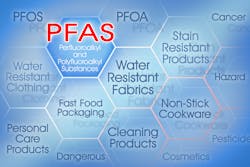New Required Reporting on PFAS Defines New Regulatory Environment
There was a time when time itself was something offered to companies to help them comply with new regulations. Well, that time is over.
A myriad of factors resulted in an announcement by the EPA on Sept. 29 that manufacturers are now required to report on the presence of 1,462 PFAS chemicals in their processes and products. And this reporting will need to go back 12 years.
Information related to chemical identity, uses, volumes made and processed, byproducts, environmental and health effects, worker exposure, and disposal needs to be reported. Specifically these changes are being made to the Toxic Substances Control Act (TSCA) in Section 8 (a) (7) Reporting and Recordkeeping Requirements for PFAS chemicals.
The timeline for manufacturers to comply with this final rule is 18 months, with an additional six months for reports from small businesses that are solely reporting data on importing PFAS contained in products.
That timeframe is particularly quick given the very complex nature of PFAS as they are spread out far and wide in most companies’ supply chains and serve a variety of functions.
New View of Managing Regulatory Compliance
Both in the present case of PFAS and in future chemical regulation companies need to adjust their timelines. "Getting ahead of what’s coming in terms of regulations by knowing what’s in our products and our supply chain is how companies can deal with these shortened times for regulatory compliance,” explains Cally Edgren, senior director of sustainability at Assent.
Having worked at large manufacturing companies over the past two decades she has seen the change. “As soon as regulatory agencies start whispering about potential changes, we need to jump on the issue. Gone are the days of having a lot of time to comply.”
The new PFAS regulation is a perfect example of the current complexity of compliance, and perhaps a blueprint for the future. The final ruling covers 1,400 substances, which is around 100 more chemicals than were first discussed in the proposed rule two years ago.
And finding data from a long and sprawling supply chain is quite daunting. “Many organizations do not yet have the functional structure in place to gather and access supplier data,” notes Edgren. “This rule signals a more comprehensive approach to PFSA management, with an emphasis on gathering more detailed information about the larger list of substances and their impacts.”
And that data is what the EPA is counting on. In the announcement on Sept. 28. “The data we’ll receive from this rule will be a game-changer in advancing our ability to understand and effectively protect people from PFAS,” said Assistant Administrator for the Office of Chemical Safety and Pollution Prevention Michal Freedhoff. “In order to effectively research, monitor, and regulate PFAS, EPA is taking action to better understand who is using PFAS, how they are being used, and in what quantities. This rule will produce actionable data that can be used by EPA, as well as state, local, and Tribal governments to craft policies and laws that protect people from dangerous “forever chemicals.”
Sorting out PFAS Usage
Addressing the dangerous angle of these chemicals can be a mixed bag, explains Edgren. Sometimes these chemicals are used as a safety chemical to prevent other known harmful chemicals from being released in manufacturing. “These chemicals are both the good guy and the bad guy, so sorting out how to keep workforces healthy is complicated."
Finding substitutes for these chemicals is also tricky and the element of time shows up again. In December of 2020, 3M announced that as of 2025 it would no longer produce PFAS. This creates a huge hole in the market, causing many companies to quickly regroup and find replacements which are not easily located and in some cases, new products are being created to fill this gap.
Drivers of Current and Future Regulations
A particularly interesting aspect of the regulation of PFAS is the many drivers of the change. Perhaps the strongest is consumer awareness of the adverse effects of these chemicals, based on public knowledge of how these chemicals are showing up in drinking water. According to a report released in July of 2023, the United States Geological Survey estimates that 45% of tap water could have one or more PFAS.
That awareness is showing up in terms of customer demands to buy products free of PFAS. An example is REI, the clothing retailer. They announced in February of 2023 that by fall of 2024, none of the products it carries will have PFAS.
Another driver is the insurance risk, notes Edgren. Since 2005 there have been 6,400 PFAS-related lawsuits. While the lawsuits have targeted companies that manufacture the chemicals, the trend is moving toward companies that use the chemicals in their processes or products.
Expanded EHS Role
With the regulatory climate changing as a result of the PFAS issue, how EHS managers deal with compliance will have to change. “Compliance can’t be seen as an ad hoc function that it used to be. Companies need to make compliance a permanent feature. Furthermore, there needs to be the understanding that product compliance is now a revenue driver as customers are making buying decisions based on compliance with regulations, as evidenced by the market for non-PFAS clothing, for example."
Edgren advises companies to make sure that there are EHS representatives in strategy sessions. “A lot of the regulatory impact is moving over to the operations side, as opposed to the strictly product side it had been.”
Moving in this direction will result in companies being better prepared for a future regulatory landscape. “Companies that proactively prepare to meet the new requirements and deploy the needed tools to capture, access and remove PFAS across their supply chain will position themselves to successfully navigate the evolving global regulatory environment,” says Edgren.
About the Author
Adrienne Selko
Senior Editor
Email [email protected]
Adrienne Selko is also the senior editor at Material Handling and Logistics and is a former editor of IndustryWeek.

